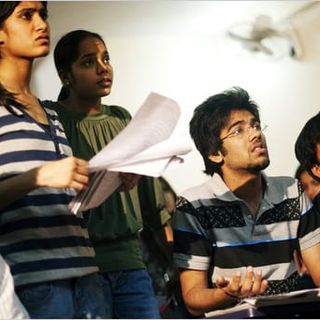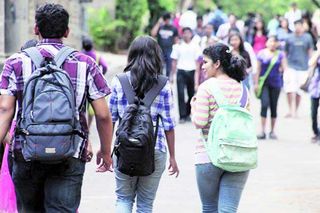
For Kids From Alternative Schools, College Can Be a Struggle
Large classes, lack of personalized attention and less freedom of choice are behind the culture shock.

Lonely, scary, overwhelming or irritating — for teens who have graduated from alternative schools, this is how many describe their first few days or months in college.
Alternative schools are known to offer an unconventional form of education, most with the aim of developing personalities rather than rankers. They offer flexible curricula and timetables, and small classes for personalized attention — so much so that in some of these schools, teachers visit students’ homes to assess how conducive their home environment is to learning. At these schools, learning occurs through play, or group activities.
Take Akshay Menon’s experience as an example. This former student of a Mumbai-based alternative school called Tridha says, “When we were learning about India’s medieval history, we decided to cover the class in a mud floor, just to see what it felt like.”
In Kunal Lalchandani’s class at Riverside School, an alternative school in Ahmedabad, only 25 children were in the classroom, four to a table. “We learned addition and subtraction through ice-cream sticks,” he says. “We didn’t rote-learn formulae, but understood the ‘why’ behind everything.”
Another Tridha student, Trisha Salvi says her class had customized desks and a library in each room. She says her school also taught her how to stitch, and how to plant, tend and pick vegetables. She learned about the constellations while camping under the stars.
Amid India’s traditional education landscape, where the teaching approach is more theoretical and focused on finishing the syllabus with hardly any personalized attention, parents are drawn to these schools for their focus on student comprehension and well-being. At these schools, learning happens through play and activities that are age-appropriate, rather than through rote memorization. Teaching is individualized to each kids’ strengths and weaknesses, rather than a systematic march through curricula that forces kids to take on new concepts without ensuring they understand the material that has come before.
Related on The Swaddle:
Explaining Preschool Philosophies: The Play Way Method
But once out of these schools, it’s not the same. And the students who learned from them describe the shift to college, where education is more syllabus-based, systematic and rewards rote learning as a culture shock.
For instance, Aryaman Jal, a former student at Andhra Pradesh’s Rishi Valley school says, “In college, we’re just faces, not names.” Now in a Mumbai college, he adds, “We are 80 students in my college class and teachers don’t know our names. I doubt they even know whether we are grasping everything.”
For Lalchandani who is now studying in a Mumbai-based college, the biggest problem he faced first from the shift was that his classmates were getting irritated at his asking questions frequently. “In school, we were told to ask whatever bothered us. In college, we were expected to keep quiet and take our problems home,” he adds.
Some other problems students from alternative schools face include being used to having an opinion and speaking their minds. “This can be perceived as an ‘attitude problem,’” says Gita Bhalla, associate director of the V Excel Educational Trust that runs the Ira Institution for Learning, which trains teachers for alternative schools.
Additional casualties from the shift include lack of personalized attention and the freedom to choose.
“I soon realized it was all about the rules. There are rules for attendance, penalties for not attending things you don’t like,” says Lalchandani of his college experience. “Anything not in the rules, no one cares about. Then it becomes about passing the buck — everyone thinks it’s the peon’s job to switch off fans and lights, upright toppled dustbins… I can’t come to terms with this approach,” he adds.
Related on The Swaddle:
Choosing a High School that’s Right for Your Teen
Interestingly, where he was once used to doing everything in a small group, he is now finding that most students are looking for or already have that one best friend.
“It gets stressful to feel like I’ve been thrown into a crowd of people I meet every day but don’t know anything about,” he says.
For Salvi, there are other worries. “The long hours and stringent deadlines make me wonder, sometimes, if I am ready for this kind of lifestyle and if this is how it is going to be when I start working,” she says.
“My peers, they’re used to this grind, this amount of homework and exam pressure. They seem able to deal with the stress much better,” she adds.
At the Eklavya school in Ahmedabad, teachers would visit each student’s house; kids would make duck ponds and tree houses on the school’s massive grounds; some classes were held in the surrounding forest.
“We were so close to our teachers that they could always tell if something was wrong,” says Sheel Parekh, now 27 and an interior designer who earlier studied in Eklavya.
Related on The Swaddle:
Explaining Preschool Educational Philosophy: Waldorf Education And More
When she shifted to another school to pursue Grade 11, since Eklavya back then was only till Grade 10, she describes the shift as bringing about a change in her personality.
“There was no campus and no place to play sports. The teachers didn’t really know the students,” she says. “The students were so used to mugging that I became afraid to ask questions and I didn’t know how I should go about writing the exams.”
A few months in, she says she just stopped caring. “I was there only to get a passing certificate. For me, my only school will be Eklavya. It pushed me to pursue my passion and understood my love for art even before I did.”
Students from alternative schools are so used to personal attention, pursuing what they like, doing things that make them happy, that following the rat race in conventional education can make them feel lost in a crowd, says Dr Samir Dalwai, developmental pediatrician and director of New Horizons Child Development Centre.
The worst of this turbulence will last, on average, a year or two. “They are used to a community, but will eventually come to terms with the more formal systems because they are still young and flexible when they make the shift,” says Dr Dalwai. But it’s an additional challenge at a stage of life that is already very confusing.
Article continues below
These challenges are teething problems, say parents. “He’ll learn to adjust; everyone does eventually,” says Lalchandani’s mother, Kiran. “It’s definitely been worth it overall. He’s been away from home and never complained about homesickness. He is always praised for how confident he is. These are a child’s real achievements, not degrees and marks, and alternative schools help you get there.”
And as far as Salvi’s mother, Rutuja, is concerned, she knew this time would come — a period of adjustment that would be relatively difficult — but the joy her daughter knew at Tridha mattered more.
“Anyway, how long can institutions promise personal attention? You grow up and learn to deal with situations on your own, and she will learn to do that, too,” Rujuta says.
For all their struggle to adjust to college, the students also say their alternative education was worth it. Parekh, who went on to pursue design at Ahmedabad’s CEPT University, credits Eklavya more than her university education with helping her achieve a job she loves.
Dr Dalwai adds, “The upside is, most already know what they want to do because their schools taught them to discover and build upon what they like, so there’s little to worry.”
Anubhuti Matta is an associate editor with The Swaddle. When not at work, she's busy pursuing kathak, reading books on and by women in the Middle East or making dresses out of Indian prints.
Related


The Toxic Culture of Sci‑Fi and Its Fanboys
